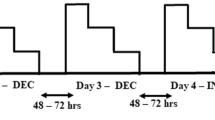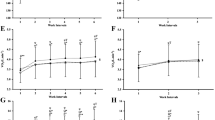Abstract
Purpose
The present study compared the efficacy of ramp incremented and ratings of perceived exertion (RPE)-clamped test protocols for eliciting maximal oxygen uptake (VO2max).
Methods
Sixteen trained cyclists (age 34 ± 7 years) performed a ramp-incremented protocol and an RPE-clamped protocol 1 week apart in a randomized, counterbalanced order. The RPE-clamped protocol consisted of five, 2-min stages where subjects self-selected work rate and pedal cadence to maintain the prescribed RPE. After completing both test protocols subjects were asked which they preferred.
Results
The mean ± SD test time of 568 ± 72 s in the ramp protocol was not significantly different to the 600 ± 0 s in the RPE-clamped protocol (mean difference = 32 s; p = 0.09), or was the VO2max of 3.86 ± 0.73 L min−1 in the ramp protocol significantly different to the 3.87 ± 0.72 L min−1 in the RPE-clamped protocol (mean difference = 0.002 L min−1; p = 0.97). Furthermore, no significant differences were observed for peak power output (p = 0.21), maximal minute ventilation (p = 0.97), maximal respiratory exchange ratio (p = 0.09), maximal heart rate (p = 0.51), and post-test blood lactate concentration (p = 0.58). The VO2max attained in the preferred protocol was significantly higher than the non-preferred protocol (mean difference = 0.14 L min−1; p = 0.03).
Conclusion
The RPE-clamped test protocol was as effective as the ramp-incremented protocol for eliciting VO2max and could be considered as a valid alternative protocol, particularly where a fixed test duration is desirable.


Similar content being viewed by others
Abbreviations
- [BLa]:
-
Blood lactate concentration
- BMI:
-
Body mass index
- HRmax :
-
Maximal heart rate
- POpeak :
-
Peak power output
- RERmax :
-
Maximal respiratory exchange ratio
- RPE:
-
Ratings of perceived exertion
- RPM:
-
Revolutions per minute
- VEmax :
-
Maximal minute ventilation
- VO2max :
-
Maximal oxygen uptake
- W:
-
Watt
References
ACSM (2010) ACSM’s guidelines for exercise testing and prescription. Lippincott Williams & Wilkins, Philadelphia
Al-Rahamneh HQ, Eston RG (2011) The validity of predicting peak oxygen uptake from a perceptually guided graded exercise test during arm exercise in paraplegic individuals. Spinal Cord 49(3):430–434. doi:10.1038/sc.2010.139
Andreacci JL, LeMura LM, Cohen SL, Urbansky EA, Chelland SA, Von Duvillard SP (2002) The effects of frequency of encouragement on performance during maximal exercise testing. J Sports Sci 20(4):345–352. doi:10.1080/026404102753576125
Antoine-Jonville S, Pichon A, Vazir A, Polkey MI, Dayer MJ (2012) Oxygen uptake efficiency slope, aerobic fitness, and V(E)-VCO2 slope in heart failure. Med Sci Sports Exerc 44(3):428–434. doi:10.1249/MSS.0b013e31822f8427
Arena R, Sietsema KE (2011) Cardiopulmonary exercise testing in the clinical evaluation of patients with heart and lung disease. Circulation 123(6):668–680. doi:10.1161/CIRCULATIONAHA.109.914788
Beaver WL, Wasserman K, Whipp BJ (1986) A new method for detecting anaerobic threshold by gas exchange. J Appl Physiol 60(6):2020–2027
Bentley DJ, Newell J, Bishop D (2007) Incremental exercise test design and analysis: implications for performance diagnostics in endurance athletes. Sports Med 37(7):575–586 (pii: 3772)
Bhambhani Y, Singh M (1985) The effects of three training intensities on VO2max and VE/VO2 ratio. Can J Appl Sport Sci 10(1):44–51
Bland JM, Altman DG (1996) Measurement error. Br Med J 313(7059):744
Borg G (1990) Psychophysical scaling with applications in physical work and the perception of exertion. Scand J Work Environ Health 16(Suppl 1):55–58
Buchfuhrer MJ, Hansen JE, Robinson TE, Sue DY, Wasserman K, Whipp BJ (1983) Optimizing the exercise protocol for cardiopulmonary assessment. J Appl Physiol Respir Environ Exerc Physiol 55(5):1558–1564
Chidnok W, DiMenna FJ, Bailey SJ, Vanhatalo A, Morton RH, Wilkerson DP, Jones AM (2012) Exercise tolerance in intermittent cycling: Application of the critical power concept. Med Sci Sports Exerc 44:966–976
Chidnok W, Dimenna FJ, Bailey SJ, Burnley M, Wilkerson DP, Vanhatalo A, Jones AM (2013) VO2max is not altered by self-pacing during incremental exercise. Eur J Appl Physiol 113(2):529–539. doi:10.1007/s00421-012-2478-6
Coquart JB, Garcin M, Parfitt G, Tourny-Chollet C, Eston RG (2014) Prediction of maximal or peak oxygen uptake from ratings of perceived exertion. Sports Med. doi:10.1007/s40279-013-0139-5
Day JR, Rossiter HB, Coats EM, Skasick A, Whipp BJ (2003) The maximally attainable VO2 during exercise in humans: the peak vs. maximum issue. J Appl Physiol 95(5):1901–1907. doi:10.1152/japplphysiol.00024.2003
Eston RG, Thompson M (1997) Use of ratings of perceived exertion for predicting maximal work rate and prescribing exercise intensity in patients taking atenolol. Br J Sports Med 31(2):114–119
Eston RG, Lamb KL, Parfitt G, King N (2005) The validity of predicting maximal oxygen uptake from a perceptually-regulated graded exercise test. Eur J Appl Physiol 94(3):221–227. doi:10.1007/s00421-005-1327-2
Eston RG, Faulkner JA, Mason EA, Parfitt G (2006) The validity of predicting maximal oxygen uptake from perceptually regulated graded exercise tests of different durations. Eur J Appl Physiol 97(5):535–541. doi:10.1007/s00421-006-0213-x
Eston R, Faulkner J, St Clair Gibson A, Noakes T, Parfitt G (2007) The effect of antecedent fatiguing activity on the relationship between perceived exertion and physiological activity during a constant load exercise task. Psychophysiology 44(5):779–786. doi:10.1111/j.1469-8986.2007.00558.x
Eston R, Lambrick D, Sheppard K, Parfitt G (2008) Prediction of maximal oxygen uptake in sedentary males from a perceptually regulated, sub-maximal graded exercise test. J Sports Sci 26(2):131–139. doi:10.1080/02640410701371364
Eston R, Evans H, Faulkner J, Lambrick D, Al-Rahamneh H, Parfitt G (2012) A perceptually regulated, graded exercise test predicts peak oxygen uptake during treadmill exercise in active and sedentary participants. Eur J Appl Physiol 112(10):3459–3468. doi:10.1007/s00421-012-2326-8
Eston RG, Crockett A, Jones AM (2014) Discussion of “The efficacy of the self-paced V̇O2max test to measure maximal oxygen uptake in treadmill running” 1. Appl Phys Nutr Metab 39(1–2). doi:10.1139/apnm-2013-0501
Evans H, Parfitt G, Eston R (2013a) Use of a perceptually-regulated test to measure maximal oxygen uptake is valid and feels better. Eur J Sport Sci. doi:10.1080/17461391.2013.832804
Evans HJ, Parfitt G, Eston RG (2013b) The perceptually regulated exercise test is sensitive to increases in maximal oxygen uptake. Eur J Appl Physiol 113(5):1233–1239. doi:10.1007/s00421-012-2541-3
Faulkner J, Eston R (2007) Overall and peripheral ratings of perceived exertion during a graded exercise test to volitional exhaustion in individuals of high and low fitness. Eur J Appl Physiol 101(5):613–620. doi:10.1007/s00421-007-0536-2
Faulkner J, Parfitt G, Eston R (2007) Prediction of maximal oxygen uptake from the ratings of perceived exertion and heart rate during a perceptually-regulated sub-maximal exercise test in active and sedentary participants. Eur J Appl Physiol 101(3):397–407. doi:10.1007/s00421-007-0508-6
Harling SA, Tong RJ, Mickleborough TD (2003) The oxygen uptake response running to exhaustion at peak treadmill speed. Med Sci Sports Exerc 35(4):663–668. doi:10.1249/01.MSS.0000058434.53664.EC
Hill AV, Lupton H (1923) Muscular exercise, lactic acid, and the supply and utilization of oxygen. Q J Med 16:135–171
Hopkins WG (2000) Measures of reliability in sports medicine and science. Sports Med 30(1):1–15
Katch VL, Sady SS, Freedson P (1982) Biological variability in maximum aerobic power. Med Sci Sports Exerc 14(1):21–25
Lamberts RP, Swart J, Woolrich RW, Noake TD, Lambert MI (2009) Measurement error associated with performance testing in well-trained cyclists: application to the precision of monitoring changes in training status. Int Sport Med J 10(1):33–44
Lucia A, Rabadan M, Hoyos J, Hernandez-Capilla M, Perez M, San Juan AF, Earnest CP, Chicharro JL (2006) Frequency of the VO2max plateau phenomenon in world-class cyclists. Int J Sports Med 27(12):984–992. doi:10.1055/s-2006-923833
Macfarlane DJ (2001) Automated metabolic gas analysis systems: a review. Sports Med 31(12):841–861
Mauger AR, Sculthorpe N (2012) A new VO(2)max protocol allowing self-pacing in maximal incremental exercise. Br J Sports Med 46(1):59–63. doi:10.1136/bjsports-2011-090006
Mauger AR, Metcalfe AJ, Taylor L, Castle PC (2013) The efficacy of the self-paced VO2max test to measure maximal oxygen uptake in treadmill running. Appl Physiol Nutr Metab 38(12):1211–1216. doi:10.1139/apnm-2012-0384
Midgley AW, McNaughton LR, Wilkinson M (2006) Is there an optimal training intensity for enhancing the maximal oxygen uptake of distance runners?: empirical research findings, current opinions, physiological rationale and practical recommendations. Sports Med 36(2):117–132
Midgley AW, Bentley DJ, Luttikholt H, McNaughton LR, Millet GP (2008) Challenging a dogma of exercise physiology: does an incremental exercise test for valid VO2max determination really need to last between 8 and 12 minutes? Sports Med 38(6):441–447
Morris M, Lamb K, Cotterrell D, Buckley J (2009) Predicting maximal oxygen uptake via a perceptually regulated exercise test (PRET). J Exerc Sci Fit 7(2):122–128
Morris M, Lamb KL, Hayton J, Cotterrell D, Buckley J (2010) The validity and reliability of predicting maximal oxygen uptake from a treadmill-based sub-maximal perceptually regulated exercise test. Eur J Appl Physiol 109(5):983–988. doi:10.1007/s00421-010-1439-1
Noakes TD (2008) Testing for maximum oxygen consumption has produced a brainless model of human exercise performance. Br J Sports Med 42(7):551–555. doi:10.1136/bjsm.2008.046821
Pivarnik JM, Dwyer MC, Lauderdale MA (1996) The reliability of aerobic capacity (VO2max) testing in adolescent girls. Res Q Exerc Sport 67(3):345–348
Poole DC (2014) Discussion: “the efficacy of the self-paced V̇O2max test to measure maximal oxygen uptake in treadmill running” 1. Appl Physiol Nutr Metab 39(1–3). doi:10.1139/apnm-2013-0549
Scharhag-Rosenberger F, Carlsohn A, Cassel M, Mayer F, Scharhag J (2011) How to test maximal oxygen uptake: a study on timing and testing procedure of a supramaximal verification test. Appl Physiol Nutr Metab 36(1):153–160. doi:10.1139/H10-099
Struthers R, Erasmus P, Holmes K, Warman P, Collingwood A, Sneyd JR (2008) Assessing fitness for surgery: a comparison of questionnaire, incremental shuttle walk, and cardiopulmonary exercise testing in general surgical patients. Br J Anaesth 101(6):774–780. doi:10.1093/bja/aen310
Twist C, Eston RG (2009) The effect of exercise-induced muscle damage on perceived exertion and cycling endurance performance. Eur J Appl Physiol 105(4):559–567. doi:10.1007/s00421-008-0935-z
Wood RE, Hills AP, Hunter GR, King NA, Byrne NM (2010) VO2max in overweight and obese adults: do they meet the threshold criteria? Med Sci Sports Exerc 42(3):470–477. doi:10.1249/MSS.0b013e3181b666ad
Acknowledgments
This project was funded by the Marywood University Graduate Research and Creative Projects Fund. The authors of this study would like to especially thank Kathy Uhranowsky, along with graduate assistants Kaleen Lavin and Nicholas Fiolo, for their assistance during data collection.
Conflict of interest
There are no conflicts of interest to report.
Author information
Authors and Affiliations
Corresponding author
Additional information
Communicated by Peter Krustrup.
Rights and permissions
About this article
Cite this article
Straub, A.M., Midgley, A.W., Zavorsky, G.S. et al. Ramp-incremented and RPE-clamped test protocols elicit similar VO2max values in trained cyclists. Eur J Appl Physiol 114, 1581–1590 (2014). https://doi.org/10.1007/s00421-014-2891-0
Received:
Accepted:
Published:
Issue Date:
DOI: https://doi.org/10.1007/s00421-014-2891-0




